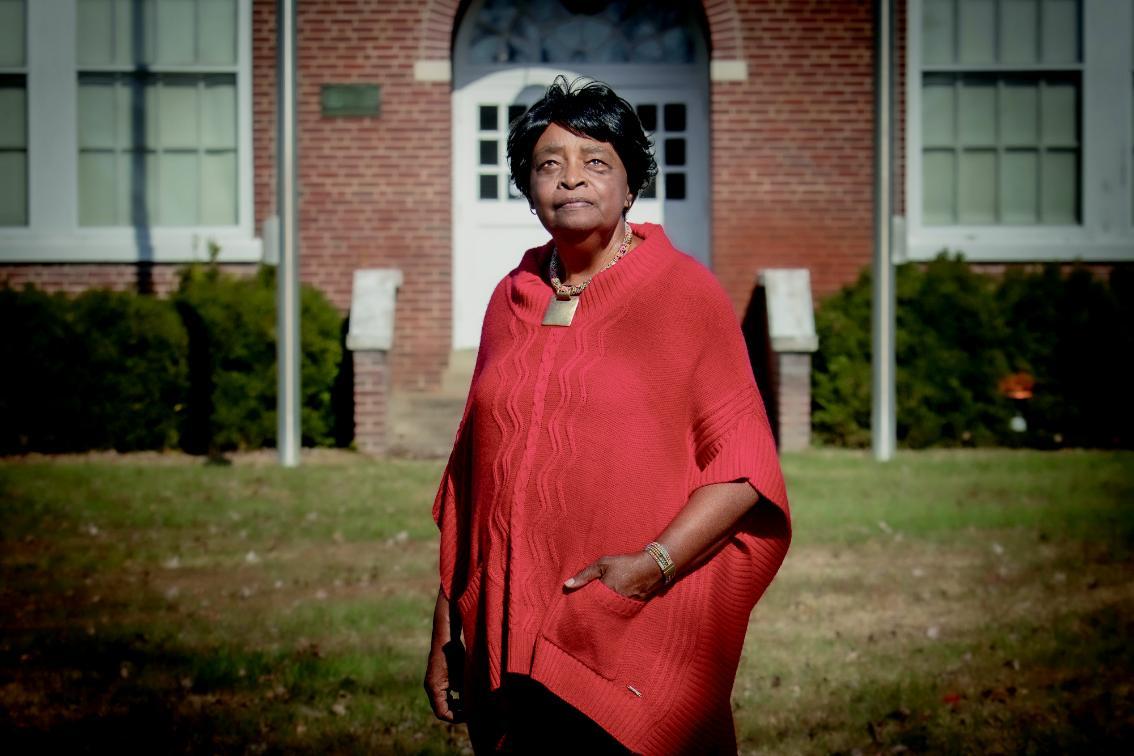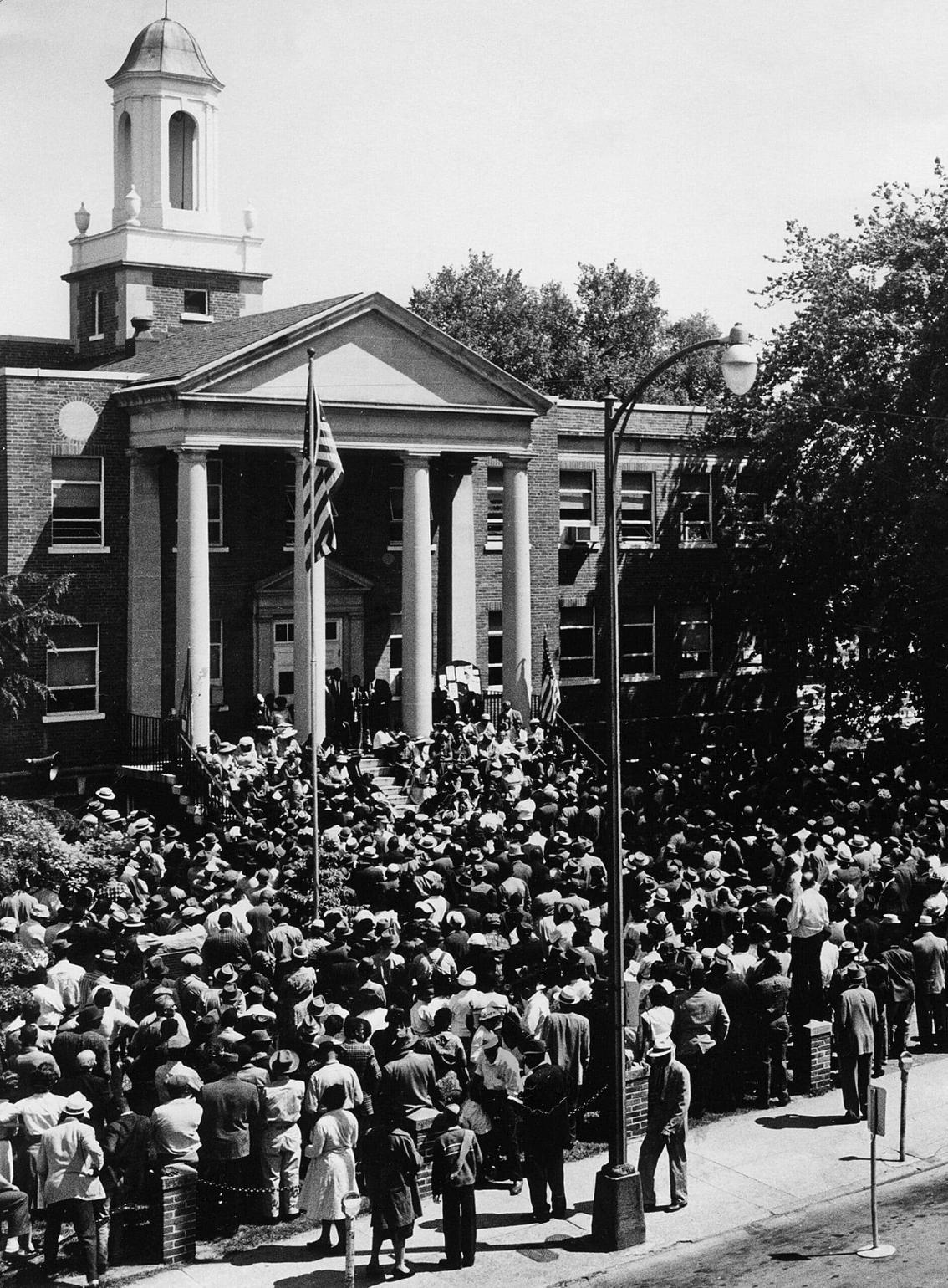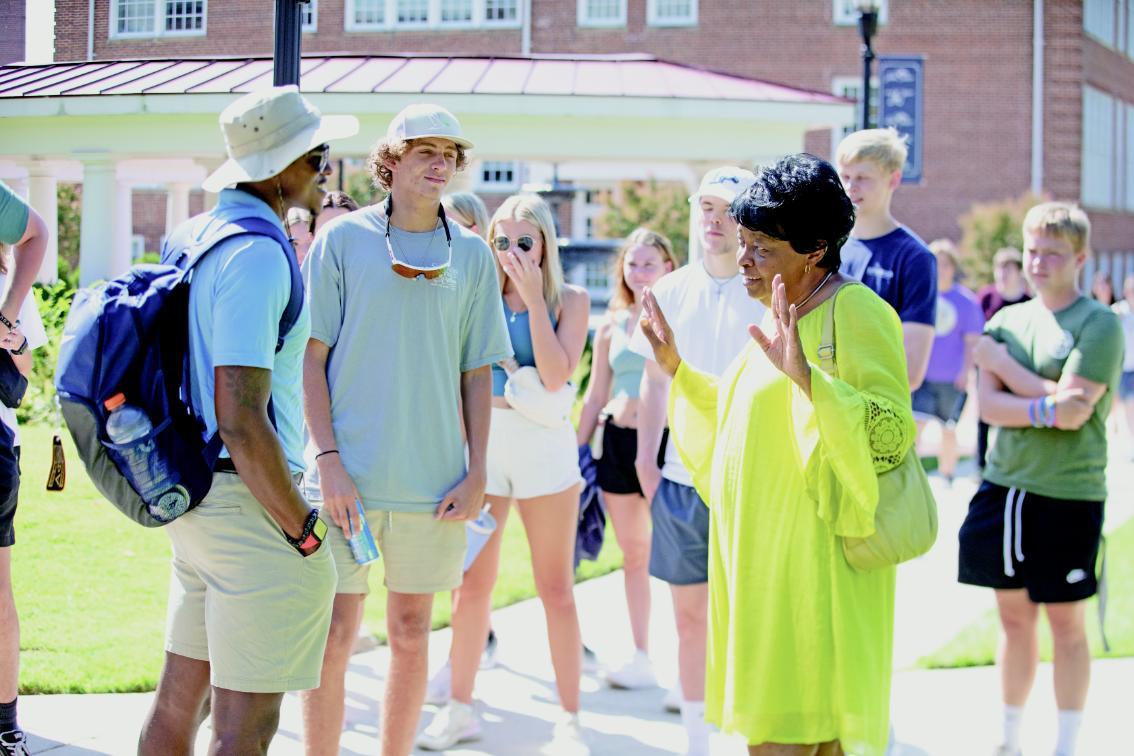

On a warm October afternoon in Grainger Hall, a freshman unlike any other stood to make her first class presentation as a Longwood student. The class was titled Writing the World, a Citizen 110 course in Longwood’s Civitae Core Curriculum taught by creative writing professor Brandon Haffner. Students had been reading Ross Gay’s 2019 The Book of Delights, a celebration of the joys and gratitude that can accumulate in everyday life. Among this group of nervous young college students, Martha Bailey Brown ’27 certainly stood out. In assignments like this, from the serious to the mundane, she draws on the experiences of a very full life—and a profoundly unique journey to Longwood.
“Now, sunglasses were the thing,” Brown began, without any sign of nervousness, giving a sassy wave of her hand. “We called them shades. And if you didn’t wear nice shades, you were square.” She was off and drawing her audience into memories—her Afro, her denim skirt and a red skirt she would wear to match her shades. “I looked so good in my shades,” she said.
The journey that brought Brown to Longwood runs through not just her life but also the broader story of Longwood and its home community of Prince Edward.
The first thing you notice about Brown is her voice. It’s sonorous and rich, lilting when she’s deep in her memories, crisp when she has something to say. She laughs easily and often.
Her love for speaking comes from her father, David Bailey, born in 1876 in Georgia, the son of emancipated slaves and a circuit preacher across the East Coast.
The family settled in the Prince Edward County community of Prospect. Brown was just 5 years old when, in 1951, Barbara Johns and her classmates walked out of R.R. Moton High School to demand better conditions. She was 7 when her father died. A year later, the Supreme Court sided with the Moton plaintiffs and struck down segregated public education in Brown v. Board of Education. And she was 13—nervously excited to start eighth grade—when Prince Edward County closed the doors of its public schools in 1959.
At first, she says, it felt like a vacation. But then as classmates and friends relocated to enroll in school in other counties and cities, a feeling emerged: loneliness. Her family wasn’t ready to uproot from their home of 20 years, and Brown kept up with schooling on her own, reading and studying her older sister’s leftover textbooks.
Two years later, in 1961, local activists and the national NAACP wanted to mark the 10-year anniversary of the Moton walkout with a rally on the Farmville courthouse steps. Organizers sought a student who had been locked out of Prince Edward schools to introduce the speakers: local activist Rev. L. Francis Griffin of First Baptist Church, Virginia NAACP civil rights attorney Oliver Hill and NAACP national executive director Roy Wilkins. Who better than the preacher’s daughter from Prospect who had inherited her father’s congregation-commanding voice? Fifteen-year-old Martha watched the rally from the podium in her lilac dress, where she channeled her father’s energy as she introduced the speakers. “It was Black folks as far as the eye could see,” she remembers.
That’s when I started crying. I was hysterical. I had no idea that had been captured and that the mural would be on the wall of the last classroom I ever had.
Martha Bailey Brown ’27 Tweet This

A half-century later, Brown attended a reunion of students locked out of the Prince Edward schools. She was touring an exhibit at the Robert Russa Moton Museum, and there it was: a mural photograph of the 1961 rally and the heroes who spoke that day. There, on the podium, is Rev. Griffin. There are Hill and Wilkins. And there, to the left, is Martha.
“I broke down,” she said. “I heaved crying, awash with memories and in recognition of that little girl sitting there with her shoulders slouched forward in that same old poor posture my mother used to get on me about. That’s when I started crying. I was hysterical. I had no idea that had been captured and that the mural would be on the wall of the last classroom I ever had.”

Over the years, Brown’s voice became her great asset—and the through line in her life.
When she attended the Free Schools, a federally organized effort to provide school to locked-out students in 1963-64, teacher Duane Jones—later a well-known actor—noticed her singing voice and tried to convince her mother to let her travel to New York and be classically trained.
The career she built was in Baltimore, where she worked for Blue Cross/Blue Shield and used her voice to advocate for patients. They put her in charge of the toughest and most complicated medical claims—a job that came with an office and an assistant. “Ha! Hot stuff!” she says about that.
My heart was saying to me, ‘Martha, it’s now. Just take the step and let life take you as it’s taken you before.
Martha Bailey Brown ’27 Tweet This
In her retirement, Brown moved back to Prospect. It was the enthusiastic ovation she got in response to her comments at a Black History Month event at Hampden-Sydney College that set in motion a dramatic change in her retirement plan. On the way home, a conversation she had with a friend about going back to school resurfaced.
“I said, ‘I’m too old. What am I going to do at college?’” she recalled. “But something kept saying to me that this was an opportunity I couldn’t walk away from. My heart was saying to me, ‘Martha, it’s now. Just take the step and let life take you as it’s taken you before.’”
Brown and her friend drove to Richmond to fill out paperwork to apply for Virginia’s Brown v. Board of Education Scholarship. Established by landmark legislation in the General Assembly, the scholarship is intended to help right the wrong perpetrated between 1959 and 1964, when students were denied an education in the Virginia public school jurisdictions that closed to avoid desegregation.
When she got the news she had been awarded the scholarship—a full ride to college—she applied to Longwood and was accepted. There was, no doubt, meaningful symbolism. In the last decade, Longwood has become a close partner of the Moton Museum and has apologized for its indifference during the civil rights era and for its use of eminent domain to take property in Black communities near its footprint. But when Brown was 18, Longwood had not yet admitted its first Black student.
“I’m just living a life that is designed for me to live,” she said. “I think that somewhere along the way, in times I know not of, I was a promise to someone. I was a promise to an ancestor. Just stay alive. You don’t know where you’re going, but stay alive. You come across an ocean and you get landed somewhere and you lose your identity, but stay alive. And here I am, the granddaughter of enslaved people—not the great-granddaughter or great-great-granddaughter, but the granddaughter—and I’m back in the place of my birth. Things were planned like that for some reason. I think there’s someone along the line whose life I’m supposed to touch so I have to be back here to do it.”
I think there’s someone along the line whose life I’m supposed to touch so I have to be back here to do it.
Martha Bailey Brown ’27 Tweet This
Now she’s back in the classroom, this time at Longwood, and using her voice in another new way. She’s a college student now, learning among others with eager minds, no matter the age difference.
“I almost don’t see the gap,” she said. “Someone congratulated me for starting over, and that phrase sounded so foreign to me. I’m not stopping something and starting over. It’s a continuum, and it’s been that way all my life.”

She arrives on campus each weekday morning, parking in the Reid Lot with other students. She makes her way to class, doing typical college student things: stopping to chat with classmates, saying hello to professors and hurrying when she’s running late.
Unlike many students, she does avoid the campus Starbucks— “I don’t need to start any caffeine addictions at my age!”
In her three classes, she contributes a different perspective in countless ways. “There are so many things I can compare my life to,” she said. “We were having a discussion in my History of Jazz class, and no one except me and the instructor knew anything about music from the ’50s and ’60s. Not only that, they don’t even know what a CD is! So it feels good to be able to share a different perspective in class discussions that my classmates find valuable.”
She’s an exploratory studies major in the Society and Culture track but is planning to switch her major to history, which puts her on track to walk across the stage at commencement in 2027 with a bachelor’s degree in a subject that she has lived as much as she has learned.
“I want to know how things connect,” she said. “To me, knowledge has always been a part of my life, finding out and learning. … As a person of faith, I believe that my steps are ordered and my paths are directed—no coincidences, only purpose. Purpose placed me in 1959-64, and ordered steps have brought me to Longwood.”
